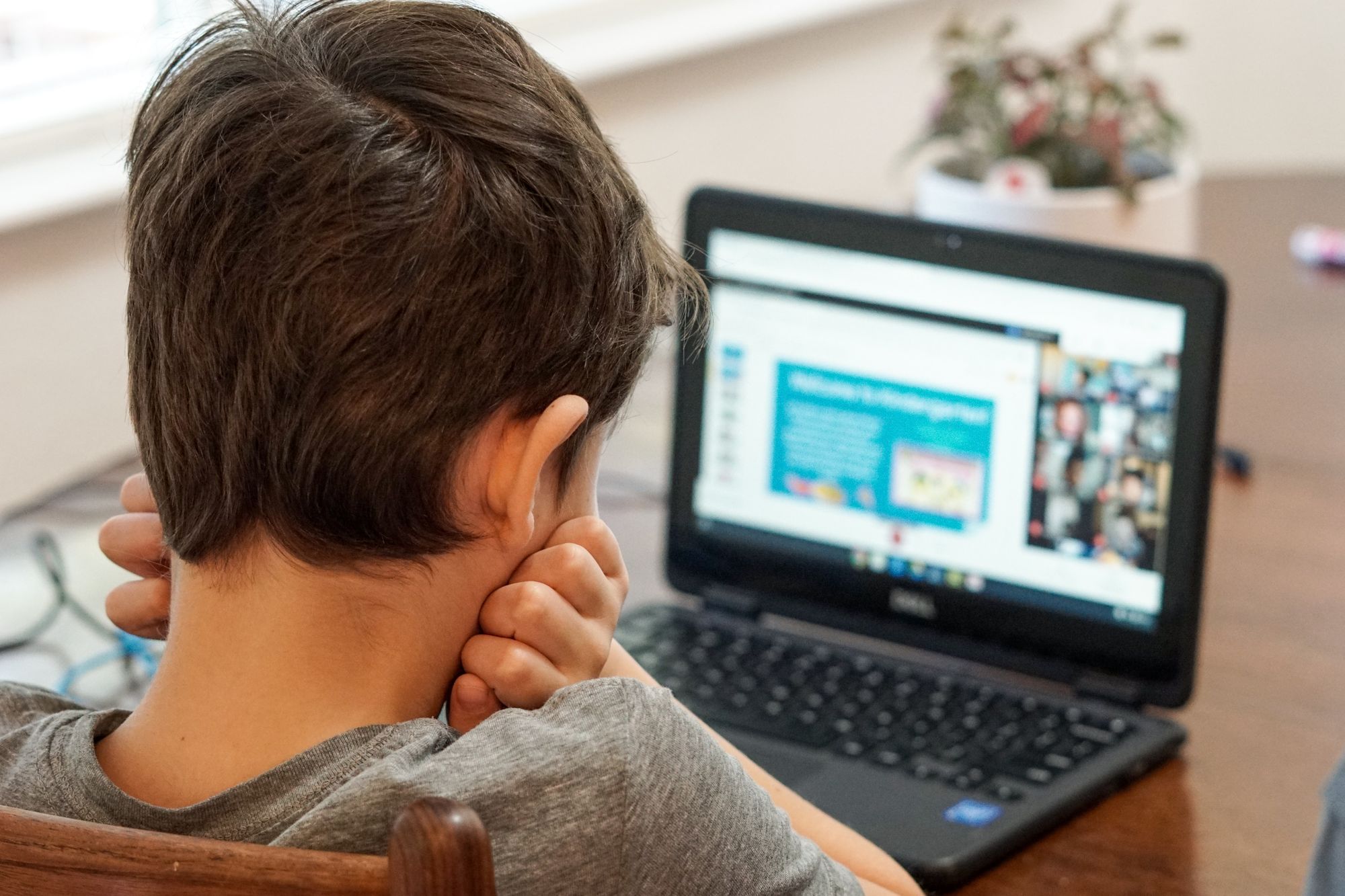Is Online Learning a Sustainable Learning Approach? An Examination on the Response to the Pandemic

By: Lin Lu & Amy Cao
Introduction
Since the start of the pandemic period, 1.37 billion students of all ages have experienced disrupted educational experiences due to school and university closures (UNESCO). With such social changes, online education with online courses and student-teacher interaction platforms emerged and populated around the world. Based on the Ministry of Education of China, “1454 Chinese colleges and universities participated in the preparation of almost 1.1 million online courses that were delivered through 12.26 million classes” (Li). The online courses range from theoretically based topics to experimental courses.
Opportunities and Challenges with Online Learning
This wide expansion of online learning has let us observe online learning’s competitive potential in future education forms. According to Ionescu, the online course approach to teaching includes course evaluation and online interaction, which can be conducted the same as in in-person schools. Ideally, online courses strive to evaluate students’ academic performance through features such as “course logins, lesson reading, lesson quiz activity, and lesson quiz scores," even though not every online course can reach such requirements (Hove, Grobbelaar). To encourage students’ participation in online courses, online platforms such as Coursera, Canvas, and EdX have also created interactive activities such as videos, group discussions, and the ability to hold online conferences. Beyond that, online courses encourage freedom in space and give time to connect for students who cannot attend and exceed the in-person courses. Additionally, online learning further improves students’ access to Information and Communication Technology (ICT). Under such advantages, according to Li, some experts have proposed a hybrid model both including online courses and in-person classes after the pandemic period when a certain emergency comes, which further requires online course evaluations such as the Online Learning Consortium Quality Scorecard Suite (Li).
However, online education during the pandemic period also brings challenges to a range of factors, from the personal level to the social level. On the personal level, the most distinctive challenge is the sudden shift from the traditional form of education to the virtual form. As online education emphasizes the importance of the Internet and the abilities of digital services, both teachers and students have to take time to adapt to the changed education form, devote more time to learn about the use of the Internet, and therefore reduce the efficiency in teaching and learning.
As Tsai found, students and faculties with more familiarity with the Internet skills such as a computer or online communication perform better in online learning and teaching (Li). Therefore, such swift changes due to COVID-19 would make students and teachers overwhelmed and experience a struggling mindset.
Additionally, the connectivity between students, their peers, and the teachers matters in students’ education learning experiences since during the courses, students basically learn most from the direct responses from their teachers and peers. Online education, to some extent, however, creates “cyber isolation” for students. The online courses that provide students only with online course materials such as textbooks and previously recorded videos may end up blocking students’ access to communicate with teachers and their peers. For instance, Abbasi et al. found 84 % of medical and dental students in Pakistan reported reduced student-instructor interactions in online learning (Zheng et al.). Therefore, online learning, in this way, reinforces the sense of social isolation.
Moreover, from the students’ perspectives, online learning reduces monitoring levels performed by a teacher and increases students’ exposure to distractions. Specifically, online learning removes the in-person presence of the teachers and students. Therefore, students have less restriction in their learning pattern, and the quarantine traits of being at home also restrained students’ personal spaces of quiet learning, reducing students’ learning performance and efficiency. Finally, from the family level, online learning can, in some ways, elevate the whole family’s burden. This is because an in-person school provides students an opportunity to enjoy free meals and provides parents relief in taking care of their children when they are working. Due to the online learning that emerged from in-person school closures during COVID-19, a family's psychological and economic stresses may be elevated in looking after their children.
Student Satisfaction
While we have analyzed certain objective aspects of the online education model, a subjective question remains: how did students view this transition from in-person classes? We will now examine many of the topics covered in earlier paragraphs–like cyber isolation, for example–through the lens of student satisfaction.
Several research studies regarding student satisfaction were conducted in relation to graduate and professional schools, such as medical and dental schools. The measured levels of satisfaction varied, but there are common contributing factors towards both satisfaction and dissatisfaction with the advent of online courses. One study conducted at a top U.S. dental school concluded that the students had overall positive attitudes towards online learning, with most courses receiving favorable ratings (Zheng et al.). The study identified the key factor for the acceptance of online education to be students' levels of engagement with their peers and instructors. Higher levels of engagement typically indicated greater acceptance and satisfaction. To add on to these positive views, a majority of these dental students also wanted to see some online education continued after the pandemic.
Consistent with this study, other findings show that Chinese students who interacted with peers and instructors displayed higher satisfaction with online learning (She et al.). Chinese university students were also found to be "highly satisfied" with online learning platforms during COVID-19, with satisfaction being impacted by their self-efficacy with technology and how useful they find the platforms (Jiang et al.).
But around the world and across different programs, student sentiment was not entirely as positive. In one medical and health science program in the United Arab Emirates, 68.7% of surveyed students were unsatisfied with online learning compared to in-person instruction (Elshami et al.). Still, in concurrence with the studies mentioned in the last paragraph, this study found that much of the dissatisfaction resulted from inaccessibility and unavailability of the instructor. In these surveys, communication and engagement, especially with instructors, were key factors to satisfaction with online learning. In the survey of UAE students, it was also found that one-third viewed technical difficulties as a reason contributing to dissatisfaction. This can be related to the findings on the relationship between technological self-efficacy and satisfaction with online learning in Chinese universities.
To gain a better understanding of how undergraduate students and potentially younger students viewed online learning, we examined popular Reddit threads and user responses. A discussion titled, "Does anyone prefer online classes?" in the large subreddit r/college received 1,200 upvotes proposing reasons for why the original poster both liked and disliked online classes (u/moonlightred10). Many of the most relevant responses (sorted by "Best") were posted two years ago, during the peak closure of schools and universities in English-speaking countries. Those responses informally confirm much of what was formally investigated in the studies mentioned above, but also shed light on the everyday aspect benefits and drawbacks to online learning.
One piece of confirmation regarding the importance of engagement is summarized by a user who writes, "social interaction loss is a huge consideration", and is also echoed by several others. Many responses report that satisfaction depends on a variety of factors like course organization and quality of instruction through an online format, which can include the ability to interact with peers and the availability of the instructor. An everyday aspect that wasn't mentioned in formal studies is the online convenience–and benefit–of not having to commute to class. While precise commute times were not often specified within responses, it was implied repeatedly that the time not spent on commuting was time freed up to pursue other tasks or hobbies. Common downsides of going remote, on the other hand, argued that online learning killed students' motivation and retainment of knowledge.
The future of online learning depends heavily on student satisfaction and how it is accepted now. The pandemic era subjected students of all ages and studies across the globe to a sudden transition in education mode. While studies report differing levels of satisfaction towards the online results of this transition, most agree that higher levels of engagement with peers and instructors during online learning contribute to higher levels of satisfaction. Technological difficulties and a potential lack of focus contribute to dissatisfaction. These points of satisfaction and dissatisfaction should be targeted to fully enhance platforms that use online education in the future.
Social Changes with Online Learning
From the social level, indeed, online learning has brought some opportunities for students and improved social education equality. Online education is basically based on the use of Internet technology such as online video, recorded lectures, and online communication platforms, such as Coursera, Canvas, and edX. These platforms provide students with access to learning materials and improve the learning experiences for certain vulnerable students, such as those with disabilities (Foxwell). For instance, students who have visual disabilities can interact with online learning technology that enables them to hear the content of the materials more clearly.
In addition, as Foxwell introduced, the online learning platforms themselves have improved their functions during the pandemic period to be more user-friendly. Examples of this include giving instructions to people who are not experienced with digital products to better inform them on how to use those platforms.
However, the fact is that online education still leaves problems and reinforces social inequalities. In fact, Internet coverage, resources for online learning infrastructures and other related funding, and professional training for teachers in the ICT and online education skills are unequally distributed. Based on Hove and Grobbelaar’s research on the influence of ICT approaches in South African education, they found that rural schools did not use ICT as a teaching approach. The biggest reasons behind that are the lack of proper infrastructure, the absence of consciousness of the importance of ICT, lack of funding to implement technology, and lack of skills to implement technology effectively (Hove, Grobbelaar).
On the contrary, urban schools, especially urban private schools with more funding and more professional training for both students and teachers in online learning strategies, reported a much higher rate of being satisfied with their schools’ use of ICT. Moreover, introduced in the World Economic Forum, 25% of 15-year-old students from disadvantaged backgrounds said that they did not have a computer to work on while for the privileged groups, all of them said that they have. Therefore, under such a situation, because of such unequal resource distribution, people struggling on the poverty lines would be affected the most by the shift to online learning since they did not have the necessary resources to support their online learning. The Human Rights Watch introduced that some classes were canceled because even the teachers did not have electricity.
Under such a situation, some governments have taken action by delivering courses through television and radio. Indeed, these actions somehow can partially solve the problem. However, such a learning pattern shift further deteriorates other inequalities. For instance, gender equality would worsen since the girls would often be forced by their families to take the chores during their learning and online learning elevated the potential since the students have to stay at home.
Online learning in Different Contexts & Countries
As referenced earlier, remote learning does not take the same form in rural towns as it does in urban cities, or from one country to the next (it doesn't even always mean "online" learning). The ways in which remote learning strategies differ can include the extent to which parental involvement is required, how much school infrastructure is utilized, or whether instruction is asynchronous (Muñoz-Najar et al.).
The World Bank Group reports that different education strategies–the Internet, mobile phones, radio, TV, and take-home packages–used during the pandemic varied greatly across geographical regions, primarily between higher and lower income countries. A slight majority (53%) of high-income countries, which had high percentages of their populations with access to the Internet and mobile phones, could rely solely on Internet access to provide remote learning. In contrast, only 9% of lower-middle-income and upper-middle-income countries provide remote learning exclusively using the Internet.
The way online learning is carried out, then, must be significantly different and varies with a unimodal or multimodal (i.e. using more than one form of remote learning at a time) approach, often hinging on the accessibility and availability of the Internet. For example, for a multimodal approach, Haiti focused on wielding online learning primarily through the Internet and a digital platform called PR@TIC, in combination with secondary resources like national television and the radio (UNESCO). In most of the United States, online learning was conducted almost exclusively through the Internet, with ready access to existing resources like Zoom for video calling and Canvas for student assignments.
Conclusion
Ultimately, the implementation of online learning during the pandemic was a necessary response to the closures of in-person schools. It can introduce benefits to students such as flexibility and physical health safety, in addition to introducing challenges. The most prominent of these challenges relate to both technological ability and getting higher levels of social interaction, the latter of which has been found to be the biggest, most consistent contributing factor to student satisfaction.
Beyond the personal level, however, access to online learning is not universal and equal in structure, consistency, or quality. A variety of factors such as access to the Internet and electricity play a large role in the ways online education is carried out. Going forward, we may see more hybrid learning models appear in universities and pre-tertiary education, in a diversity of forms. At the very least, the post-pandemic world of online education has a precedent to learn from.
Works Cited:
“1.37 Billion Students Now Home as COVID-19 School Closures Expand, Ministers Scale up Multimedia Approaches to Ensure Learning Continuity.” UNESCO, 21 Apr. 2022, https://www.unesco.org/en/articles/137-billion-students-now-home-covid-19-school-closures-expand-ministers-scale-multimedia-approaches.
Elshami, Wiam, et al. “Satisfaction with Online Learning in the New Normal: Perspective of Students and Faculty at Medical and Health Sciences Colleges.” Medical Education Online, vol. 26, no. 1, 11 May 2021, https://doi.org/10.1080/10872981.2021.1920090.
Foxwell, Amy. “Equality of Access in Education during and after COVID-19.” ReadSpeaker, 14 Sept. 2022, https://www.readspeaker.com/blog/equality-of-access-in-education/.
Hove, Precious, and Sara S. Grobbelaar. “Innovation for Inclusive Development: Mapping and Auditing the Use of Icts in the South African Primary Education System.” South African Journal of Industrial Engineering, vol. 31, no. 1, 2020, pp. 47–64., https://doi.org/10.7166/31-1-2119.
Ionescu, Constantin Aurelian, et al. “Sustainability Analysis of the e-Learning Education System during Pandemic Period—COVID-19 in Romania.” Sustainability, vol. 12, no. 21, 30 Oct. 2020, p. 9030., https://doi.org/10.3390/su12219030.
Jiang, Haozhe, et al. “Online Learning Satisfaction in Higher Education during the COVID-19 Pandemic: A Regional Comparison between Eastern and Western Chinese Universities.” Education and Information Technologies (Springer), vol. 26, 31 Mar. 2021, pp. 6747–6769., https://doi.org/10.1007/s10639-021-10519-x.
Li, Cathy, and Farah Lalani. “The COVID-19 Pandemic Has Changed Education Forever. This Is How.” World Economic Forum, 29 Apr. 2020, https://www.weforum.org/agenda/2020/04/coronavirus-education-global-covid19-online-digital-learning/.
Li, Dan. “The Shift to Online Classes during the COVID-19 Pandemic: Benefits, Challenges, and Required Improvements from the Students’ Perspective.” Electronic Journal of e-Learning, vol. 20, no. 1, 2022, https://doi.org/10.34190/ejel.20.1.2106.
Muñoz-Najar, Alberto, et al. "Remote Learning During COVID-19: Lessons from Today, Principles for Tomorrow." The World Bank, 2021, https://documents1.worldbank.org/curated/en/160271637074230077/pdf/Remote-Learning-During-COVID-19-Lessons-from-Today-Principles-for-Tomorrow.pdf.
Park, Thomas. Kindergarten boy looking at laptop computer during first day of virtual learning online school. 20 August 2020. Unsplash, https://unsplash.com/photos/6MePtA9EVDA.
“PR@TIC, a Digital Platform for the Continuity of Education in Haiti.” UNESCO, 21 Apr. 2022, https://www.unesco.org/en/articles/prtic-digital-platform-continuity-education-haiti.
She, Long, et al. “Online Learning Satisfaction during COVID-19 Pandemic among Chinese University Students: The Serial Mediation Model.” Frontiers in Psychology, Edited by Jesús-Nicasio García-Sánchez, vol. 12, 5 Oct. 2021, https://doi.org/10.3389/fpsyg.2021.743936.
Sheppard, Bede. “Years Don't Wait for Them: Increased Inequalities in Children's Right to Education Due to the COVID-19 Pandemic.” Human Rights Watch, 17 May 2021, https://www.hrw.org/report/2021/05/17/years-dont-wait-them/increased-inequalities-childrens-right-education-due-covid.
Spratt, Annie. Young teen doing schoolwork at home after UK schools close due to the Coronavirus. 20 March 2020. Unsplash, https://unsplash.com/photos/4E1JOFK55kc.
U/moonlightred10. "Does anyone prefer online classes?" Reddit, 2021, https://www.reddit.com/r/college/comments/m21cht/does_anyone_prefer_online_classes/.
Zheng, Meixun, et al. “Online Learning during COVID-19 Produced Equivalent or Better Student Course Performance as Compared with Pre-Pandemic: Empirical Evidence from a School-Wide Comparative Study.” BMC Medical Education, vol. 21, 16 Sep. 2021, https://doi.org/10.1186/s12909-021-02909-z.




